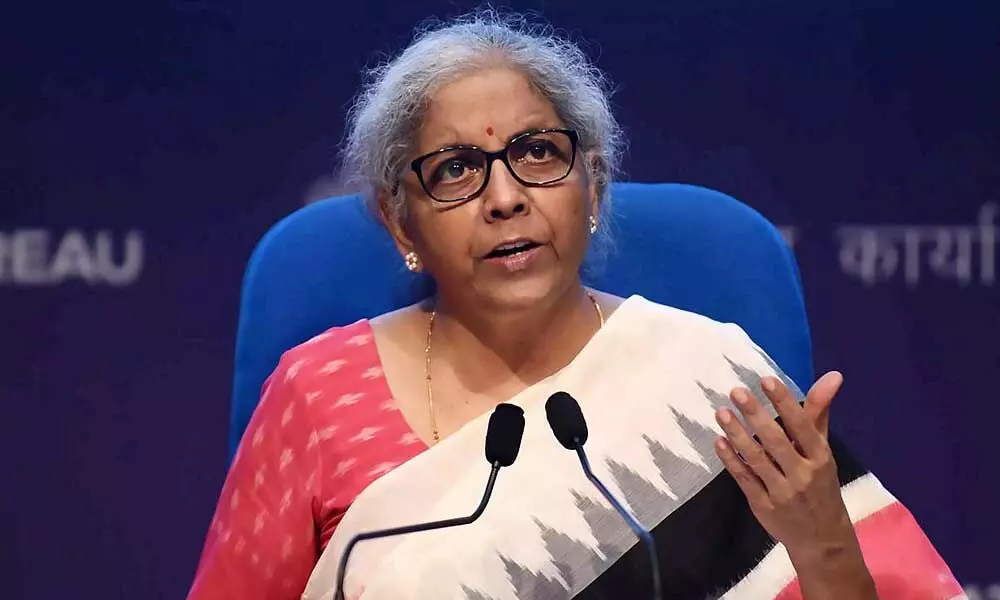Nirmala rules out waiving off NPAs
Banks make provision for bad debts for accounting process and writing off doesn’t mean waiving off amount: Nirmala Sitharaman
image for illustrative purpose

5,200 Firms In NPA Fold
- 5,623 entities with large credit exposure as of March 31, 2021
- Cos with credit exposure of over Rs5 cr declared as NPAs till Dec 2021
- However, the number of such firms decreasing
- Banks took action against 11.25 lakh borrowers under the SARFAESI Act from 2015-16 to 2020-21
New Delhi: The writing off the NPAs doesn't translate to waiving off the amount, said Finance Minister Nirmala Sitharaman in response to a question by Sriperumbudur MP TR Baalu on Monday in the Lok Sabha during Question Hour.
The Finance Minister informed the House that as part of the accounting process, banks make a provision for the money which is due from the NPA account and in that process we call it as the writing off.
Sitharaman added the pursuing of the defaulter is followed up. She apprised the Lower House that several public sector banks have got their money back by claiming assets and securities of the defaulter. "First time NPAs are being pursued and actions are being taken on them. NPAs were previously left by the dozen and tons during UPA rule. Money was never obtained from these defaulters to go back to the banks," Nirmala Sitharaman added.
Bad Loans
More than 5,200 companies having credit exposure of Rs 5 crore or above were categorised as non-performing assets (NPAs) or bad loans on the banks' books as of December 31, 2021, Parliament was informed on Monday.
Scheduled commercial banks (SCBs) and all Indian financial institutions report certain credit information of all borrowers having aggregate credit exposure of Rs5 crore and above to the RBI, under its CRILC database, since the quarter ended June 2014, Minister of State (MoS) for Finance Bhagwat Karad said.
The number of unique borrowers having aggregate credit exposure of Rs5 crore and above, identified as companies, and classified as non-performing assets (NPA) stood at 5,231 as of December 31, 2021, Karad said in a written reply to the Lok Sabha.
The Central Repository of Information on Large Credits (CRILC) is tasked to collect, store, and disseminate credit data to lenders. Under this, banks are required to furnish credit information to CRILC on all their borrowers, having aggregate fund-based and non-fund based exposure of Rs5 crore and above. The number of companies with large credit exposure fell when compared to 5,623 such entities as of March 31, 2021, the Minister said citing data from the Reserve Bank of India (RBI). Further, he said that the RBI data maintained since 2015-16 shows that action has been initiated against 11.25 lakh borrowers by banks under the SARFAESI Act from 2015-16 to 2020-21. "RBI has informed that the details of properties attached under Securitisation and Reconstruction of Financial Assets and Enforcement of Security Interest (SARFAESI) Act, 2002, are not maintained at it," Karad said.
On being asked if the government has any data on the number of suicides that took place as a result of non-availability of sufficient bank credit, rising interest rates, unauthorised private lending apps among others, he said there were a total of 5,213 cases related to suicides due to bankruptcy or indebtedness in 2020, citing data from the National Crime Records Bureau (NCRB). In reply to a separate question on illegal lending apps, he said "As per the findings of the RBI's Working Group on digital lending, the number of illegal lending apps stood at approximately 600 from January 1, 2021, to February 28, 2021". As per the RBI, its 'Sachet' portal mechanism for registering complaints by the public against unregistered entities has received approximately 2,562 complaints against digital lending apps from 1 January 2020 to 31 March 2021, Karad added.
The pursuing of the defaulter is followed up. First time NPAs are being pursued and actions are being taken against defaulters. NPAs were previously left by the dozen and tons during UPA rule. Money was never obtained from these defaulters to go back to the banks
—Nirmala Sitharaman, Finance Minister

